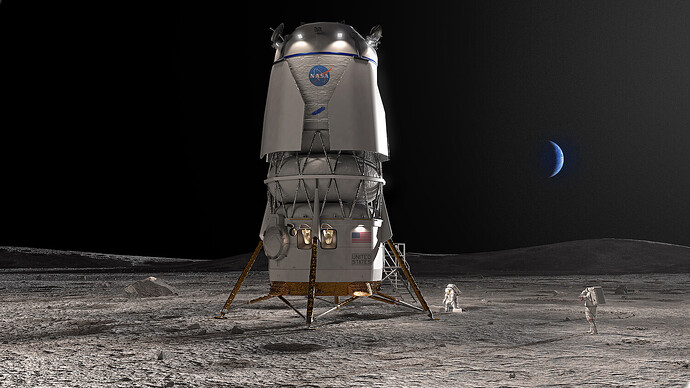NASA will announce the second source for the Artemis project Human Landing System on 2023-05-19 at 14:30 UTC. In April 2021, SpaceX won the initial contract to develop the Human Landing System to take crews from lunar orbit to the surface of the Moon and back. It was NASA’s original plan to choose two vendors, providing redundancy if one encountered development problems or its system were to be grounded for an extended period after entering service, but the budget allotted to the Artemis program was insufficient to procure two independent lander designs. The U.S. congress subsequently appropriated funds and directed NASA to contract with a second vendor, resulting in this competition whose winner will be announced tomorrow.
SpaceX is not a competitor this time—having won the initial competition and subsequently being awarded a follow-on contract for a second lander, this competition is for a vendor to provide an alternative landing system, just as SpaceX and Boeing (maybe, someday) provide crew launch services to the International Space Station. NASA has not released the names of the competitors for this contract. Two of the teams who lost to SpaceX on the first round, one led by Blue Origin and the other by Dynetics, have announced they are competitors, but there may be other entrants in this round whose names have not been disclosed.
There is no dedicated Webcast of this event. It will be covered live on the NASA TV YouTube channel, which you can watch with the player at the top of this post. Coverage is scheduled to start at 14:00 UTC with the contract award announcement event beginning at 14:30 UTC.
As with the SpaceX contract, NASA will not own the lander hardware, but rather contract with the chosen vendor to provide landing services for its lunar missions. All of the landing missions after the first (Artemis III) are planned to carry the landing crew from the Lunar Gateway in a near-rectilinear halo orbit around the Moon to the lunar surface and back to the Gateway.
2 Likes
The contract was awarded to the “National Team” led by Blue Origin and including Lockheed Martin, Draper, Boeing, Astrobotic, and Honeybee Robotics.
Under this contract, Blue Origin and its National Team partners will develop and fly both a lunar lander that can make a precision landing anywhere on the Moon’s surface and a cislunar transporter. These vehicles are powered by LOX-LH2. The high-specific impulse of LOX-LH2 provides a dramatic advantage for high-energy deep space missions. Nevertheless, lower performing but more easily storable propellants (such as hydrazine and nitrogen tetroxide as used on the Apollo lunar landers) have been favored for these missions because of the problematic boil-off of LOX-LH2 during their long mission timelines. Through this contract, we will move the state of the art forward by making high-performance LOX-LH2 a storable propellant combination. Under SLD, we will develop and fly solar-powered 20-degree Kelvin cryocoolers and the other technologies required to prevent LOX-LH2 boil-off. Future missions beyond the Moon, and enabling capabilities such as high-performance nuclear thermal propulsion, will benefit greatly from storable LH2. Blue Origin’s architecture also prepares for that future day when lunar ice can be used to manufacture LOX and LH2 propellants on the Moon.
The second source lander is expected to fly on the Artemis V flight, currently scheduled for September 2029. This lander design is substantially different from that which Blue Origin bid for the original procurement won by SpaceX. The lander is now completely reusable, leaving nothing on the Moon, and can be configured for either human or cargo (20 tonne) landings. The lander is planned to shuttle back between the Gateway and lunar surface, with refuelling at the Gateway with propellants launched from Earth. One lander is expected to be used for “multiple landings over multiple years”. An unmanned demonstration mission is planned for a year before the crewed mission, which will perform an autonomous landing on the Moon and return to the Gateway.
1 Like

